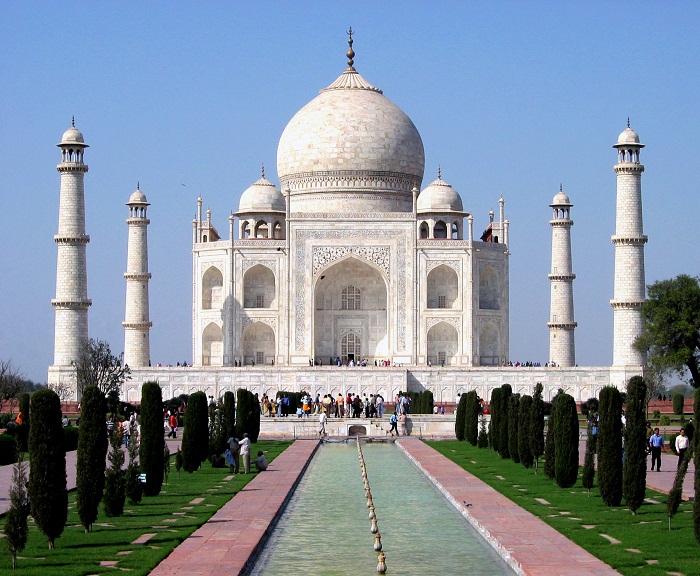A route in India generally includes a trip to Agra, one of the three cities forming the “Golden Triangle”, in order to visit his famous and iconic Taj Mahal. Located at 230km from the Indian capital of Delhi, the city of Agra welcomes every year millions of visitors coming to admire the monuments and their exceptional architecture. Among all, we have selected for you the 10 sights of Agra except Taj Mahal.
Most of the time your trip to Agra will only last one or two days, and the time will not be enough to visit all the monuments. As well, it is preferable to organize his route in advance by taking into account each time to visit. However, a came to Agra must not be synonymous of marathon of visits; enjoy rather of places and their unique environment by taking your time.

Find here about the 10 must see attractions of Agra including Taj Mahal:
1. Taj Mahal
Symbolic monument of India, this mausoleum built by the Mughal Emperor Shah Jahan for his deceased wife Mumtaz Mahal, alone represents the eternal love. Completed in 1648, the monument today is virtually identical to that of the time, and his entire site figure in the world heritage of UNESCO.
2. The Red Fort of Agra
The Red Fort of Agra is part of the largest forts in India. Classified in the world heritage of UNESCO, it is the second monument the most visited of Agra after the Taj Mahal. It is also one of the most ancient historical monuments built of sandstone, since it was built in the sixteenth century under the reign of the Mughal emperor Akbar.
3. Itimad-ud-Daulah
This mausoleum built in 1628 welcomes the body of Mirza Ghiyas Beg, the grand-father of the Mumtaz Mahal. It is her daughter Nur Jahan, wife of the emperor Jahangir, who ordered the construction. The site is considered the precursor of the Taj Mahal, and Door of elsewhere the nickname of “Baby Taj”.
4. The tomb of Akbar the Great
This monument was built in 1613 in honor of Akbar the Great, one of the Sovereign of the most important of the Mughal empire. It is he himself who began the construction of the Mausoleum, but it is his son Jahangir who ended. On the places, you will be able to observe the mixing of styles religious of Indian architecture, very representative of the thoughts of Akbar.
5. Jama Masjid
Built in 1648 by the Emperor Shah Jahan, this mosque was dedicated to his daughter Jahanara preferred Begum. It is part of the largest mosques in India and was formerly connected to the Fort of Agra. Its architecture reflects the traditional beauty of the Iranian ART.
6. The tomb of Mariam-uz-Zamani
The tomb of Mariam-Uz-Zamani houses the body of Jodha Bai, the favorite wife of the Mughal emperor Akbar, and which has given birth to his successor Jahangir. Of Hindu religion but married to a Mughal emperor Muslim, she was buried according to Islamic customs, but his body was also cremated according to the Hindu faith.
7. Khas Mahal
Khas Mahal located in fort of Agra, a palace built in 1640 by the Emperor Shah Jahan for his daughters Roshnara and Jahanara. The interior of the Palace is adorned with gold, murals, of floral decorations. The gold and blue, the two royal colors of the time, were widely used in the ornament interior of the palace, and today we can still see a few traces.
8. Chini ka Rauza
As many of the monuments in India, the Chini ka Ruaza is a mausoleum. It was erected in the honor of Allama Afzal Khan mullah, the Prime Minister during the reign of Shah Jahan. This building is one of the best examples of the work of the TILE glass by the Mughals. The Monument takes its name colorful tiles that come from China.
9. Panch Mahal
The Panch Mahal is a construction of five floors located in Fatehpur Sikri. It was built by the Emperor Akbar who used this building as a place of relaxation and entertainment. Its structure was inspired by that of the Buddhist temples.
10. Jahangir Mahal
The Palace of Jahangir represents the greater part of the Fort of Agra. It is a complex mixture of architectures that shows the Alliance of Islamic arts and Hindus. Only 30 of the 500 buildings of the site are still present to this day. Most were destroyed in a first time by Shah Jahan and then by the British invaders.
The above all 10 sites that will fill you with wonder and make you discover the art and the beliefs of the Mughal era. Its almost 400 years now and who do not cease to attract still more tourists from around the world because of their exceptional beauty and their unique history. Agra is an inescapable city during your stay in India and promises you memories without such.

